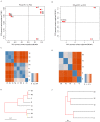Analysis of microbial community composition and diversity in postoperative intracranial infection using high‑throughput sequencing
- PMID: 29067467
- PMCID: PMC5646973
- DOI: 10.3892/mmr.2017.7082
Analysis of microbial community composition and diversity in postoperative intracranial infection using high‑throughput sequencing
Abstract
Intracranial infection is one of the most serious complications following neurosurgery. It is well acknowledged that bacteria and fungi are the main pathogens responsible for postoperative intracranial infection. However, the microbial community structure, including composition, abundance and diversity, in postoperative intracranial infection is not fully understood, which greatly compromises our understanding of the necessity and effectiveness of postoperative antibiotic treatment. The present study collected eight cerebrospinal fluid (CSF) samples from patients with intracranial infection following neurosurgical procedures. High‑throughput amplicon sequencing for 16S rDNA and internal transcribed spacer (ITS) was performed using the Illumina MiSeq platform to investigate the microbial community composition and diversity between treated and untreated patients. Bioinformatics analysis revealed that the microbial composition and diversity in each patient group (that is, with or without antibiotic treatment) was similar; however, the group receiving antibiotic treatment had a comparatively lower species abundance and diversity compared with untreated patients. At the genus level, Acinetobacter and Staphylococcus were widely distributed in CSF samples from patients with postoperative intracranial infection; in particular, Acinetobacter was detected in all CSF samples. In addition, five ITS fungal libraries were constructed, and Candida was detected in three out of four patients not receiving antibiotic treatment, indicating that the fungal infection should be given more attention. In summary, 16S and ITS high‑throughput amplicon sequencing were practical methods to identify pathogens in the different periods of treatment in patients with postoperative intracranial infection. There was a notable difference in microbial composition and diversity between the treated and untreated patients. Alterations in the microbial community structure may provide a signal whether antibiotic treatment worked in postoperative intracranial infection and may assist surgeons to better control the progression of infection.
Figures




References
-
- Liu CX, Wan DJ, Li JL, Yang H, Chao GQ. Clinical analysis on intracranial infection after craniocerebral operation. Chinese J Nosocomiol. 2000;10:4–7.
-
- Smuts H, Botha G, Stanley A, Hardie D. Viruses in CSF of HIV patients with acute and late onset neurological conditions detected by NGS. International J Infectious Diseases. 2014;21:124. doi: 10.1016/j.ijid.2014.03.685. - DOI
-
- Wu HM, Cordeiro SM, Harcourt BH, Carvalho M, Azevedo J, Oliveira TQ, Leite MC, Salgado K, Reis MG, Plikaytis BD, et al. Accuracy of real-time PCR, Gram stain and culture for Streptococcus pneumoniae, Neisseria meningitidis and Haemophilus influenzae meningitis diagnosis. BMC Infect Dis. 2013;13:26. doi: 10.1186/1471-2334-13-26. - DOI - PMC - PubMed
MeSH terms
Substances
LinkOut - more resources
Full Text Sources
Other Literature Sources
Medical

